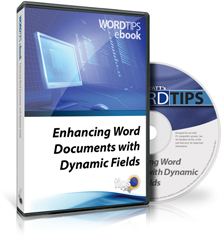Enhancing Word Documents with Dynamic Fields
Summary: Add a field to your document and you add dynamic content. Word provides a wide variety of fields that can be used in a number of ways. Uncover the many ways you can use Word's field codes to make your documents better.

One of the very first ways that Microsoft enabled Word users to add dynamic content to their documents was through the use of fields. In Word-speak, a field is a mnemonic code that represents other data. Whenever the field is updated by Word, the code is replaced with the data that it represents. For example, a field code might be UserInitials, and this code is dynamically replaced in your document with the user's initials.
At last count Word provides almost 90 different codes that can add everything to your document from page numbers to hyperlinks. What is returned by most of these fields can be modified or adapted through the use of switches. All told, fields offer a wildly diverse means of adding information to your document that is dynamic—it can change over time.
How can you make sense of the myriad of fields and switches available in Word? This can be a perplexing question, which is why I've created Enhancing Word Documents with Dynamic Fields, Fourth Edition, to help you make sense of the fields that Word places at your fingertips. Not in some stuffy, academic, "rote list" manner, but in a way that allows you to actually start using fields to enhance your documents right away. This e-book contains information on virtually all of the fields that you can use in Word.
I say "virtually all" because, quite honestly, there are a few field codes that you won't find mentioned in these books. You see, some other features of Word—such as indexes and tables of contents—are implemented through the use of fields. Those types of features are best covered in their own e-books instead of the more far-ranging treatment provided to fields in this book. To get information on how these specialized types of fields are used, see these e-books:
Everything else that is useful, helpful, and enabling—if it has to do with fields—is included in this e-book. In fact, Enhancing Word Documents with Dynamic Fields contains a whopping 329 pages of information about putting fields to work right away. Just take a look at the TOC for the e-book to get an idea of the information it contains.
The download file for Enhancing Word Documents with Dynamic Fields contains the e-book in two formats: Microsoft Word and Adobe Acrobat (PDF). In these formats you enjoy the following features:
- The ability to view, search, and print the book.
- Screen shots that illustrate what you see in Word as you follow the step-by-step instructions.
- The ability to select and copy sections of text, such as macro code.
- Hyperlinks to internal content (in the book itself) and referenced resources on the Web.
 If you decide to access the e-book in PDF format (both the Word and PDF formats contain the same information), you need to either have Acrobat or the free Adobe Acrobat Reader. Many computer systems already have the reader installed. If you do not, you can get it free, directly from Adobe.
If you decide to access the e-book in PDF format (both the Word and PDF formats contain the same information), you need to either have Acrobat or the free Adobe Acrobat Reader. Many computer systems already have the reader installed. If you do not, you can get it free, directly from Adobe.
How much does all this value cost you? You can download your own copy of any version of this valuable information for the low price of only $29.99. Place your order today!
When you click on a "Buy Now" link above, that product is added to your shopping cart. You can then click the shopping-cart icon, in the lower-right corner, to begin the checkout process.
Important Ordering Notes:
If you live in a European Union (EU) country, please do NOT order the CD-ROM. Your order will go through, but I will need to then cancel the order. The reason is simple: The EU requires the procurement of a special shipping license (for the lack of a better term) that makes it onerous and economically untenable for a small company such as mine to ship physical products into EU countries. Please, order a downloadable product, instead. There are no restrictions (yet) on downloadable products.
If you live in a country that imposes value-added taxes (VAT) and you order a physical product, you will need to pay the VAT when the order is delivered to you. I do not collect VAT at the time of ordering, nor is the VAT included in your purchase price.
You can also order Enhancing Word Documents with Dynamic Fields by calling our order line: 307-200-0450.
